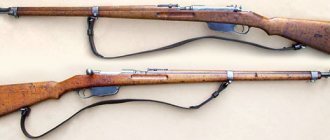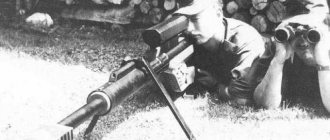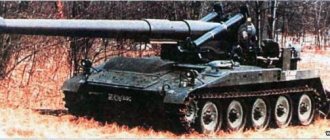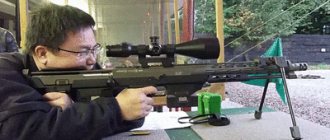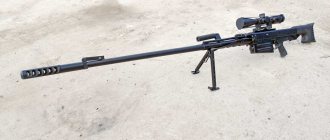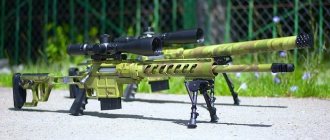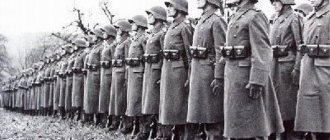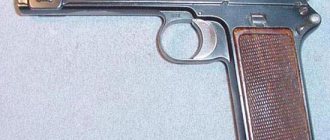The ZF69 telescopic sight mounted on the Steyer SSC 69 sniper rifle had a range range of up to 800 m. Typically, this weapon was produced with a five-round magazine, but there were modifications for a 10-round magazine.
The Steyer SSC 69 rifle became the standard weapon for snipers in Austrian mountain infantry units. In the mountains, one sniper armed with it could delay the advance of enemy troops for a long time. The advantages of the rifle include its ability to maintain combat properties in the harshest conditions.
SSG 69 is the designation adopted in the Austrian army for the Steyer-Mannlicher sniper rifle, adopted for service in 1969. The abbreviation SSG stands for "Scharfschuetzengewehr" (sniper rifle). It is in service and in lyceum units and is produced in various modifications - from the “Polis” with a super-heavy barrel and an enlarged bolt handle to the modern SSG P11 sniper/target rifle.
The history of the design of this rifle dates back to the beginning of the 20th century. The bolt and magazine have not undergone significant changes since the Mannlicher-Schönauer rifle of the 1903 model was designed for the Greek army. The shutter opens manually and is locked by six special protrusions located symmetrically in the rear part.
Rear locking tabs
The placement of locking lugs at the rear was first successfully used in the famous Lee-Enfield rifle. Theoretically, this is dangerous, since the entire length of the bolt is subject to load during the shot. However, in practice, neither the Mannlichers nor the Lee-Enfields suffered from this. Many shooters were able to appreciate the benefits of this design: the cartridge was sent into the chamber without having to go some more distance for the bolt protrusions to fit into the cutouts. Thus, reloading became smoother and faster, in addition to this there was also a drum magazine, which fed cartridges more synchronously than a conventional spring-loaded magazine.
The 650 mm long barrel had a recess in the muzzle, rifled (four rifling with a pitch of 305 mm). It was made by cold forging: a metal blank was put on a mold (a steel strip with threads) and processed with a rotating hammer from the outside and inside.
Sniper rifle Steyr SSG 69
| SSG 69 PI military version |
In 1969, Steyr-Daimler-Puch AG (later Steyr-Mannlicher AG), based on a hunting rifle, released the SSG-69 sniper rifle (ScharfSutzenGewehr 69 - sniper rifle model 1969), with modifications for 7.62x51 and . 243.
When developing the rifle, it was subject to rather strict requirements of 80% probability of hitting (without taking into account the characteristics of the shooter) a chest figure at a distance of up to 600 m, a tall figure - up to 800 m.
The rifle barrel is made by cold forging. A core form is inserted inside the workpiece. As a result of hammer blows, the inner and outer surfaces are formed simultaneously. This process, originally developed by , has been widely used in the manufacture of barrels throughout the world. It provides reinforcement to the surface of the bore and its outer side. In addition, the bore of the SSG 69 rifle is slightly narrowed.
| SSG 69 PII police variant |
Reloading is done manually, with the bolt rotating 60 degrees. On the rear of the bolt there are six locking lugs arranged symmetrically. The principle of locking the main body of the bolt ensures its shorter stroke, in contrast to the Mauser system, in which locking is carried out by the front part (combat cylinder) of the bolt. However, this method has always been considered undesirable, because the recoil impulse is transmitted to the entire bolt, and not just to its combat cylinder. The survivability of the shutter is reduced and the length of the locking unit increases. In addition, the body of the rifle itself is weakened due to a cutout on the right side in front of the support arms of the receiver. This deficiency in the SSG 69 rifle is compensated to some extent by strengthening and lengthening the receiver. In this case, the chamber is placed inside the receiver, which makes the barrel together with the receiver more reliable. The shutter handle is bent down.
The trigger mechanism provides for release with a warning (“double” pressing the trigger - selecting the free stroke all the way and release) and has external devices for adjusting the force and length of the trigger stroke. The safety, located on the right side of the rear of the receiver, is a sliding type. He locks the bolt and firing pin.
The rifle has a standard 5-round magazine, which has been used in Mannlicher sporting and combat rifles for many years. A 10-round box magazine can also be used.
SSG 69 main components and assemblies
The one-piece stock is made of synthetic materials, has a shape with a pistol lug of the neck and a marking on the forend and pistol lug. Finish black or green. Removable butt pads allow you to adjust its length.
On top of the receiver there is a longitudinal ridge on which sighting devices are attached. The standard sight is the Kakhles ZF 69 (6x42 class) or ZFM. The ZF 69 sight has graduations up to 800 meters and internal adjustment. The sight is attached to the comb with clamping rings. The rifle has a soldered open sight with a triangular slot. In addition, illuminated and non-illuminated night sights can be installed. The SSG SD variant has a cylindrical silencer that completely covers the barrel in front of the forend and thus does little to change the balance of the weapon.
In 1986-87, the Steyr SSG rifle could have become the M24, that is, the standard sniper weapon of the US Army. However, the victory went to Remington's Model 700 due to greater accuracy at distances over 600 meters. However, at shorter firing ranges, both rifles showed almost the same accuracy (less than one arc minute).
| SSG 69 PIV |
The SSG 69 became one of the best military-type sniper rifles and an excellent choice when it came to shooting at a distance of no more than 500 meters and at one time became the standard sniper rifle not only for the army and police of Austria, but also for more than a dozen countries.
The production of Steyr SSG sniper rifles was launched in 4 modifications - SSG-PI, SSG-PII, SSG-PIIK and SSG-PIV.
| Caliber, mm | 7.62×51 NATO (.308), .243 Win |
| Length, mm | 1140 |
| Barrel length, mm | 650 |
| Weight without cartridges, kg | 3.9 4.6 (with optical sight) |
| Magazine capacity, no. cartridges | 5 (drum type) 10 (box type) |
| Initial bullet speed, m/s | 860 |
| Sighting range, m | 800 |
The SSG-PI was originally designed as an anti-sniper rifle, having both conventional sighting devices (front and rear sights) and mounts for an optical sight, and has a barrel length of 650 mm. The SSG-PII was created for the police, has a heavy barrel of the same length and does not have conventional sights. The SSG-PIIK has a shorter (508 mm) barrel length, which, however, did not affect accuracy at distances up to 500 meters. SSG-PIV is known as SSG SD in Europe. It has an even shorter barrel (406 mm), threaded for installing a flash suppressor or silencer.
In addition to combat models of rifles, the production of a target version of the SSG 69 “Steyr-Match” was launched with a weighted barrel chambered for the RWS cartridge and a modified stock shape made of plastic or walnut. A “Walter” system sight and a ring-type front sight are installed. According to the manufacturer, when shooting RWS sports cartridges, the average deviation is: 10 shots at 300 m - 90 mm; 10 shots at 400 m - 130 mm; 10 shots at 600 m - 200 mm; 10 shots at 800 m - 400 mm.
| SSG 69 PIV with silencer installed police version |
Spiral barrel
This processing method has been developed and used by many firearms manufacturers. With this treatment, the barrel acquires a characteristic spiral shape and a noticeable narrowing from the breech to the muzzle. The SSG 69's barrel is screwed into the receiver to a length of 57 mm, which is significantly further than most other rifles. When the barrel has taken its position, the connection point is crimped in a circle, resulting in a very strong and reliable fastening, however, replacing the barrel with this technology is only possible in the factory.
The movement of the bolt of the SSG 69 rifle is very smooth, since Teflon is used in its coating. There is a cocking indicator. The two-position safety, which can be used whether the rifle is cocked or not, is a sliding latch on the right side of the receiver that, when engaged, prevents movement of the bolt.
The safety is practically silent, so no one will hear the characteristic click, which means that a shot will soon follow. The P11 rifle can be optionally equipped with a double trigger, which is really only suitable if the shooter has small hands. The modular design of the rifle makes it very easy to change the trigger mechanism, although the new mechanism is very expensive.
The standard magazine holds five rounds and is made of plastic with a clear insert so the shooter can see how many rounds are left. You can also install a 10-round magazine. In terms of shooting accuracy, the SSG 69 rifle is approximately comparable to other modern sniper rifles.
Users[edit]
- Argentina: Used by the Argentine Army. [9]
- Austria: Used by the Austrian Army and EKO Cobra. [6] [10]
- Chile [11]
- China: Limited use in the Sino-Vietnamese War. [12]
- Salvador [13]
- Germany: German police units. In the possession of the Munich police during the terrorist attack at the 1972 Summer Olympics in Munich, but not used.
- Lebanon: Lebanese Armed Forces [ citation needed
] - Greece [14]
- India: Used by BSF and COBRA (CRPF). [15]
- Indonesia: Used Kopaska.
- Ireland: Garda Emergency Response Team [16] [17]
- Israel: Used by YAMAM in the 1980s. [18]
- Jordan [9]
- South Korea [19]
- Myanmar: probably used from Singapore and Pakistan [20]
- Netherlands: Marine Corps [21] [22]
- Pakistan: Used by the Pakistan Army. [23]
- Peru [9]
- Poland [24]
- Russia: Special forces use small numbers. [ citation needed
] - Singapore Used by the Singapore Armed Forces, currently being withdrawn from service and replaced by the TRG-22 and transferred to reserve units.
- Saudi Arabia[ citation needed
] - Slovenia: Used by Slovenian Army special forces.
- South Africa: Used by special forces [ citation needed
] - Syria [9] Free Syrian Army: Fighters acquired SSG 69 Snipers. [25]
Story
It was adopted by the Austrian Army in 1969 (hence its name), a sniper rifle that was ahead of its time by using polymer and cold-forged barrels for increased durability. In addition to being the standard sniper rifle of the Austrian Army, it is also used by various law enforcement agencies. It is very accurate and has won several international shooting competitions due to its accuracy of less than 0.5 MDA.
In 2015, the manufacturer of the SSG 69, Steyr Mannlicher, decided to cease production. [ 8 ]
Links[edit]
- "Modern Firearms". Archived from the original on September 1, 2010. Retrieved November 14, 2014.
- "Ground Zero: Syria (Part 7) - Aleppo Snipers - YouTube". youtube.com. Retrieved September 5, 2015.
- https://www.youtube.com/watch?v=_beWFtnhl98
- ":404". Archived from the original on August 10, 2014. Retrieved November 14, 2014.
- Jump up
↑ Hogg, Ian (1989).
Jane's Infantry Weapons 1989–90 15th Edition
. Jane Information Group. p. 125. ISBN 0-7106-0889-6. - ^ ab "Scharfschützengewehr 69". Bundesheer - Waffen und Gerät
. Bundesministerium für Landesverteidigung. Archived from the original on November 7, 2014. Retrieved November 14, 2014. - Manual Kahles ZF 84
- "Steyr SSG 69 in retirement". Firearms Blog
. February 23, 2015. Archived from the original on July 11, 2022. Retrieved July 10, 2022. - ^ abcde Jones,
Richard D.
Infantry Weapons 2009/2010
. Jane Information Group; 35th edition (January 27, 2009). ISBN 978-0-7106-2869-5. - Meug Eitan (January 6, 1999). "Special weapons for counter-terrorism units". Jane - Law Enforcement
. Jane Information Group. Archived from the original on March 1, 2008. Retrieved September 26, 2009. - Gander, Terry J.; Hogg,
Ian W.
Weapons , 1995/1996
. Jane Information Group; 21st edition (May 1995). ISBN 978-0-7106-1241-0. - [1]
- ↑
Montes, Julio A. (May 2000).
"Infantry weapons of Salvadoran troops". Small Arms Review
. Vol. 3 pcs. 8. Archived January 19, 2022. Retrieved January 19, 2022. - "Image: 7.62mm Steyr SSG sniper rifle.jpg, (800 × 410 pixels)". greekmmilitary.net. Archived from the original on October 29, 2015. Retrieved September 5, 2015.
- "Times of Hindustan". Archived from the original on March 3, 2016. Retrieved February 20 +2016.
- "IRISH ARMY RANGERS". Tactical Life
. Archived from the original on October 2, 2013. Retrieved November 14, 2014. - "Garda College Yearbook lists weapons training on page 66" (PDF). Archived from the original on January 24, 2014 (PDF). Retrieved February 11, 2014.
- [2]
- "ҿ ù ƴ ƴ". Archived from the original on November 29, 2014. Retrieved November 14, 2014.
- "Trade Register 1990-2019". Stockholm International Peace Research Institute
. Retrieved April 28, 2022. - Materiel of the Dutch Marine Corps (Dutch) Archived March 30, 2012 at the Wayback Machine
- "Royal Netherlands Marine Corps, Dutch Main Expeditionary Force". Archived from the original on January 17, 2012. Retrieved November 14, 2014.
- "Pakistan Army". Archived from the original on October 12, 2013.
- Kochansky, Stanislav (1992). Jrygady antyterrorystyczne Operacje Uzbrojenie
. SIGMA NOT. ISBN 83-85001-66-2. - image of an FSA member sniping with a STEYR SSG 69 in Syria. [ need better source
] - "Tunisian special forces (exclusive and inclusive)". Defense of Pakistan
. Archived from the original on April 16, 2013. Retrieved November 14, 2014. - "Archival copy". Archived from the original on March 25, 2014. Retrieved March 25, 2014.CS1 maint: archived copy as title (link)
- "Image: 190963_polis-ozel-harekat.jpg, (333 × 248 pixels)". image.samanyoluhaber.com. Archived from the original on November 24, 2015. Retrieved September 5, 2015.
- "Steyr SSG 69 Sniper Rifle". www.mmilitary-today.com
. Archived from the original on July 5, 2022. Retrieved July 10, 2022.
